This lesson will talk about intersection of two lines, and concurrency of three lines.
To be precise, we’re dealing with two questions here:
1) How do we find out the point of intersection of two lines?
2) How can we tell whether three lines are concurrent (i.e. pass through the same point)?
Let’s start with the first.
Intersection of Two Lines
Suppose the lines 2x + y = 4 and x + y = 3 intersect at the point (a, b).
That means, the point (a, b) must lie both the lines, or its coordinates must satisfy both the equations.
On substituting the coordinates in both the equations, we’ll get:
2a + b = 4
a + b = 3
On solving these for a and b, we get a = 1 and b = 2. Therefore, the point of intersection will be (1, 2).

We can ignore the a and b, and directly solve the two equations for x and y. The solution (x, y) will give the coordinates of the point of intersection.
There may be some cases in which we will not get a solution. Here’s an example.
Consider the lines 2x + y = 4 and 4x + 2y = 0. Try to solve these two equations. You won’t get any solution!
What does that mean geometrically? Well, it means that the lines do not intersect. Or, the lines must be parallel.
Here’s a figure to illustrate.

The method of solving equations will give the points of intersection of any two curves in general.
For example, if we want to find out the intersection of this strange looking curve x2 + 2y = 3x and the line x + y = 1, we just have to solve these equations to get the values of x and y.
If we get more than one solution, that means there is more than one intersection point. Similarly, no solution implies the curves do not intersect.
Let’s move to the second question.
Concurrency of Three Lines
Suppose we have three lines:
2x + y = 4
x + y = 3
y = 2x
Are these lines concurrent? That is, do they pass through the same point? How can we tell?
To check that, we’ll find the point of intersection of any two lines, and substitute its coordinates in the third. If they satisfy the third equation as well, that means the lines are concurrent. Otherwise, they’re not.
We’ve already found the point of intersection of the first two lines, i.e. (1, 2). Let’s substitute the coordiantes in the third equation. We’ll get:
LHS = 2
RHS = 2(1) = 2 = LHS
That means the point (1, 2) lies on the line y = 2x as well, implying that the three lines are concurrent. Have a look.

Let’s generalize this. Suppose we have the following three lines:
a1x + b1y + c1 = 0
a2x + b2y + c2 = 0
a3x + b3y + c3 = 0
Then, if these are concurrent, what must be the relation between the coefficients?
If they’re concurrent, then the point of intersection of the any two lines must lie on the third.
The point of intersection of the first two lines will be:
\((\frac{b_1c_2-b_2c_1}{a_1b_2-a_2b_1}, \frac{c_1a_2-c_2a_1}{a_1b_2-a_2b_1})\)
Before moving on, we need to take care about that term in the denominator, i.e. a1b2 – a2b1. What if it equals zero?
Well, it cannot. Why? Because if it does, then a1b2 – a2b1 = 0, will lead to -a1/b1 = -a2/b2 , which implies the slopes of the lines will be equal, which means the lines will be parallel, which means that they cannot intersect!
But they do! Therefore, a1b2 – a2b1 cannot equal 0.
Moving on. Now, for concurrency, the third line must also pass through this point. Therefore, the above coordinates must satisfy the third equation.
Substituting those scary coordinates in the third equation, and after some simplification, we’ll get the following relation:
a3(b1c2 – b2c1) + b3(c1a2 – c2a1) + c3(a1b2 – a2b1) = 0
This relation can be written in a fancy way as:
\(\begin{vmatrix}a_1&b_1&c_1\\a_2&b_2&c_2\\a_3&b_3&c_3\\\end{vmatrix}=0\)
That nice looking 3 x 3 arrangement of things is known as a determinant. And it is easier to remember than the previous scary result.
Lesson Summary
- To find the point of intersection of two lines, we’ll solve the two equations in x and y. Then (x, y) will be the point of intersection.
- To check if three lines are concurrent, we’ll find the point of intersection of any two of these lines, and check if the coordinates satisfy the third equation. If they do, then the lines are concurrent. Otherwise, they’re not.
See you in the next lesson, where I’ll cover slope of a line.